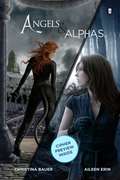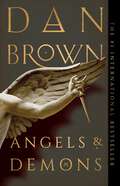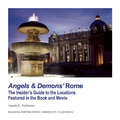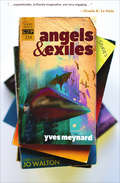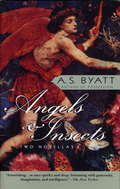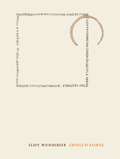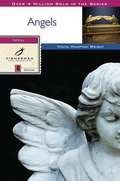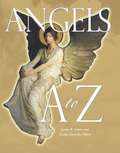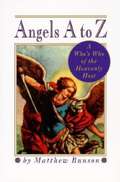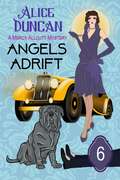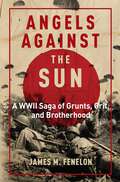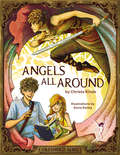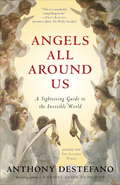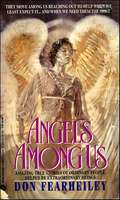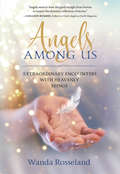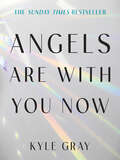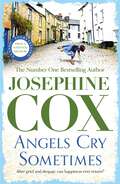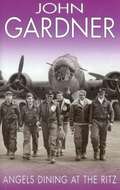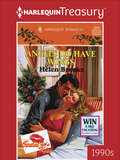- Table View
- List View
Angels & Alphas
by Christina Bauer Aileen ErinBecoming AlphaTessa doesn't realize that kissing the wrong guy in her new Texas town could land her in far more trouble than she ever imagined. Like being forced to attend St. Ailbe's Academy, a secret boarding school for werewolves. Even if the wrong guy did accidentally turn her into one of "them," Tessa can't help her growing attraction to the mysterious Dastien Laurent. But when vampires attack St. Alibe's and her visions pinpoint an enemy in their midst, Tessa realizes that boy drama and her newfound canine tendencies might just be the least of her problems.AngelboundEighteen-year-old Myla Lewis is a girl who loves two things: kicking ass and kicking ass. She's not your every day quasi-demon, half-demon and half-human, girl. For the past five years, Myla has lived for the days she gets to fight full-blooded demons in Purgatory's Arena. But when the demons start to act weird, even for demons, and the King of Hell, Armageddon, shows up at Myla's school, Myla knows trouble is coming with a capital T. Things heat up when Myla meets Lincoln, a super-sexy half-human and half-angel demon hunter. But what's a quasi girl to do when she falls for a demon hunter? With a love worth fighting for, Myla may just shake up Purgatory.Bonus Preview: CipherIn the not-too-distant future, the color of your helix tattoo shows your DNA's quality...and Cipher's red helix is a death sentence that's kept her on the run for twelve years. Now, Cipher wants her life back. Hacking into the Citadel mainframe is a huge risk, and the only person in the Arizona Voids that can help her is her oldest friend, Knight. She hasn't seen him in person since she started running, and Knight 2.0 is fully upgraded with a six-pack and knee-melting smile. For a girl like Cipher, trust doesn't come easily, but Knight makes her yearn for a life she knows she can't have, especially when every secret she reveals endangers them both.
Angels & Demons (Robert Langdon Ser. #Bk. 1)
by Dan BrownThe explosive Robert Langdon thriller from Dan Brown, the #1 New York Times bestselling author of The Da Vinci Code, The Lost Symbol, Inferno, and The Secret of Secrets. An ancient secret brotherhood. A devastating new weapon of destruction. An unthinkable target. When world-renowned Harvard symbologist Robert Langdon is summoned to his first assignment to a Swiss research facility to analyze a mysterious symbol—seared into the chest of a murdered physicist—he discovers evidence of the unimaginable: the resurgence of an ancient secret brotherhood known as the Illuminati...the most powerful underground organization ever to walk the earth. The Illuminati has now surfaced to carry out the final phase of its legendary vendetta against its most hated enemy—the Catholic Church. Langdon’s worst fears are confirmed on the eve of the Vatican’s holy conclave, when a messenger of the Illuminati announces they have hidden an unstoppable time bomb at the very heart of Vatican City. With the countdown under way, Langdon jets to Rome to join forces with Vittoria Vetra, a beautiful and mysterious Italian scientist, to assist the Vatican in a desperate bid for survival. Embarking on a frantic hunt through sealed crypts, dangerous catacombs, deserted cathedrals, and the most secretive vault on earth, Langdon and Vetra follow a 400-year-old trail of ancient symbols that snakes across Rome toward the long-forgotten Illuminati lair...a clandestine location that contains the only hope for Vatican salvation. Critics have praised the exhilarating blend of relentless adventure, scholarly intrigue, and cutting wit found in Brown’s remarkable thrillers featuring Robert Langdon. An explosive international suspense, Angels & Demons marks this hero’s first adventure as it careens from enlightening epiphanies to dark truths as the battle between science and religion turns to war.
Angels & Demons Rome
by Angela K. NickersonRetrace the steps of Robert Langdon, Vittoria Vetra, the Hassassin, and the camerlengo, to find a new and exciting perspective on the city of Rome.
Angels & Exiles: Stories
by Yves MeynardAn “unpredictable, brilliantly imaginative, and very engaging” collection of dark fantasy and sci-fi stories by the acclaimed author of Chrysanthe (Ursula K. Le Guin). In these fourteen stories, ranging from baroque science fiction to bleak fantasy, Yves Meynard brings to life wonders and horrors. From space travelers who must rid themselves of the sins their souls accumulate in transit to a young man whose love transcends time; from refugees in a frozen hold at the end of space to a city drowning under the weight of its architectural prayer; from an alien Jerusalem that has corrupted the Earth to a land still bleeding from the scars of a supernatural war, here are windows opened onto astonishing vistas, stories written with a scientist’s laser focus alloyed with a poet’s sensibilities. “These stories cover a vast range. . . . Some are fantasy, some are science fiction, and many of them cover an interesting middle ground between the two—a form I think of as myths of the future, and of which Meynard has a special mastery.” —Jo Walton, from the introduction
Angels & Insects
by A. S. ByattIn these breathtaking novellas, A.S. Byatt returns to the territory she explored in Possession: the landscape of Victorian England, where science and spiritualism are both popular manias, and domestic decorum coexists with brutality and perversion. Angels and Insects is "delicate and confidently ironic.... Byatt perfectly blends laughter and sympathy [with] extraordinary sensuality" (San Francisco Examiner).
Angels & Saints: With A Guide To The Illustrations By Mary Wellesley
by Eliot WeinbergerA gorgeously illustrated co-publication with Christine Burgin by “one of the world’s great essayists” (The New York Times). With a guide to the illustrations by Mary Wellesley. Angels have soared through Western culture and consciousness from Biblical to contemporary times. But what do we really know about these celestial beings? Where do they come from, what are they made of, how do they communicate and perceive? The celebrated essayist Eliot Weinberger has mined and deconstructed, resurrected and distilled centuries of theology into an awe-inspiring exploration of the heavenly host. From a litany of angelic voices, Weinberger’s lyrical meditation then turns to the earthly counterparts, the saints, their lives retold in a series of vibrant and playful capsule biographies, followed by a glimpse of the afterlife. Threaded throughout Angels & Saints are the glorious illuminated grid poems by the eighteenth-century Benedictine monk Hrabanus Maurus. These astonishingly complex, proto-“concrete” poems are untangled in a lucid afterword by the medieval scholar and historian Mary Wellesley.
Angels (Fisherman Bible Studyguide Series)
by Vinita Hampton WrightWhat Do We Really Know About Angels?What--or who--are angels? Where did they come from, and what is their purpose? What is their relationship to us as human beings?This studyguide explores the numerous Bible passages that reveal the services these heavenly beings perform, the part they play in spiritual warfare, and how they differ from other beings in God's created order.Most importantly, you'll learn to see angels in the fuller context of God's presence, glory, and eternal purposes.
Angels 101: An Introduction To Connecting, Working, And Healing With The Angels
by Doreen Virtue"Do you have a book about angels for someone who's a complete beginner?" Doreen Virtue frequently hears this question at her workshops, and usually points them to her book Healing with the Angels. Yet, even that book is a bit advanced for newcomers. One morning she clearly saw and heard the title Angels 101, and Doreen knew that the angels wanted her to write a very basic and elementary book. Angels 101 is a nondenominational overview of who the angels are; their role in various spiritual texts and religions; the ways that angels help us and how to call upon them; information on guardian angels, archangels, and departed loved ones; and frequently asked questions about the angels. No matter where you are on a spiritual or religious path, this book is sure to deepen your understanding and love of the angels-and it makes the perfect gift for someone new to these concepts!
Angels A to Z
by Evelyn Dorothy Oliver James R LewisWritten by recognized authorities on nontraditional religious movements, this resource is one of the most comprehensive books on angels and related topics currently available. More than 300 entries are included and drawn from multiple religions, including Christianity, Islam, and Hindu, as well as from pop culture.
Angels A to Z: A Who's Who of the Heavenly Host
by Matthew BunsonAmid the veritable choirs of popular angel books, this is the only one that offers factual information on every facet of angel lore. Here at last is a detailed reference for anyone who wants to finally get the straight dope on all aspects of angel arcana. 40 photos.
Angels Adrift: Historical Cozy Mystery (Mercy Allcutt Mystery #6)
by Alice DuncanBoston Socialite Cracks Band of Bootleggers in Angels Adrift, a Historical Cozy Mystery from Alice Duncan1926, Pasadena, CAMercy Allcutt's imagination is more exciting than her job as secretary to P.I., Ernie Templeton. As usual, she has nothing to do except gaze out the office window overlooking Pasadena and imagine the plots of stories she plans to write someday.Generally, when she watches the alley behind the Figueroa Building, she needs to imagine someone being strangled, today was different. She calls the police to report the murder but the corpse is gone before she hangs up the phone.Ernie tries his best to convince her it was her imagination. The police find nothing. Now her reputation is on the line as well as her aspirations for becoming a P.I.With her boardinghouse tenants as advisors, she launches her own investigation, putting her and her friend Lulu right in the middle of a band of bootleggers who don't like nosy secretaries or their friends. Now, Mercy needs to save herself and Lulu before they both wind up floating in a Venice canal.Publisher Note: Readers who enjoy cozy mysteries in historical settings are sure to appreciate the Mercy Allcutt series set in 1920s Los Angeles, California. No vulgarity or explicit sex for those who appreciate a clean and wholesome read.The Mercy Allcutt Mystery SeriesLost Among the AngelsAngels FlightFallen AngelsAngels of MercyThanksgiving AngelsAngels AdriftChristmas Angels
Angels Against the Sun: A WWII Saga of Grunts, Grit, and Brotherhood
by James M. FenelonIn the tradition of Band of Brothers, historian and former paratrooper James M. Fenelon offers a grunt&’s-eye view of the 11th Airborne&’s heroic campaign to liberate the Philippines in World War II. A soldier&’s history at its best.A Grunt&’s-Eye View of Pacific WarfareThe Pacific theater of World War II pitted American fighting men against two merciless enemies: the relentless Japanese army and the combined forces of monsoons, swamps, mud, privation, and disease. General Joseph Swing&’s rowdy paratroopers of the 11th Airborne Division— nicknamed the &“Angels&”—fought in some of the war&’s most dramatic campaigns, from bloody skirmishes in Leyte&’s unforgiving rainforests to the ferocious battles on Luzon, including the hellish urban combat of Manila. The Angels were trained as elite shock troops, but high American casualties often forced them into action as ground-pounding infantrymen. Surviving on airdropped supplies and reinforcements, the Angels fought their way across nearly impassable terrain, emerging as one of the most lethal units in the Pacific War. Their final task was the occupation of Japan, where they were the first American boots on the ground. Angels Against the Sun is an unforgettable account of the liberation of the Philippines. In the tradition of Band of Brothers, historian and former paratrooper James M. Fenelon offers a grunt&’s-eye view of the war. This is a soldier&’s history at its best.
Angels All Around (Threshold Series Prequel)
by Christa J. Kinde Anna EarleyThe prequel to the popular Threshold Series by Christa Kinde, Angels All Around is an illustrated short story set in a small town where not everyone is what they seem. Amidst the chaos and confusion, will a new divine Messenger become one little girl’s prince, and a fledgling Guardian become their knight, or will evil take its hold? Includes a bonus first chapter from Book #1 in the Threshold series, The Blue Door!
Angels All Around Us
by Anthony DestefanoIn Angels All Around Us, the international bestselling author of A Travel Guide to Heaven and Ten Prayers God Always Says Yes To explains the awesome and mysterious reality of the spiritual dimension that surrounds and permeates our very existence. All aspects of the spiritual realm are discussed, including the existence of angels and demons, the whereabouts of loved ones who have passed, the gift of grace, heaven, hell, and even the presence and activity of God in our lives. Completely consistent with traditional Christian teaching, Angels All Around Us will help readers embrace a certitude that makes it easier to act according to their moral beliefs, give them a greater sense of the richness of life, and show them that no amount of suffering--physical, mental, or emotional--will ever be able to destroy the profound sense of inner peace that they can experience on a daily basis.
Angels Among Us
by Don FearheileyGale was a strong swimmer -- but halfway across the lake she realized she couldn't make it to the other side ...Annabel and her three-year-old daughter turned suddenly -- and saw a car hurtling straight toward them ...Ken fell and his hunting rifle accidentally went off -- leaving him wounded, bleeding and alone in the frozen woods...and then they appeared! Angels do exist -- as illustrated in these moving,compelling and true contemporary accounts of ordinary people whose lives were touched and saved by the extraordinary.
Angels Among Us: Extraordinary Encounters with Heavenly Beings
by Wanda RosselandA vision in a dream. A long-awaited healing. Protection from an accident waiting to happen. Angels Among Us is a collection of stories of everyday people—little children, old women, young men, and more—who had their lives stopped for a moment and redirected with a little help from above. Some came to help. Some to heal. Others stood as protectors and guardians. Some were prayed for and others showed up totally unbidden, but all were remembered by those whose lives were changed from a visit by their guardian angel. These inspiring stories will give you comfort and hope as you learn that you are seen, protected, and loved throughout each and every day.
Angels And Demons: Have Wings - Will Travel (People's Bible Teachings)
by John D SchuetzeDo angels and demons exist?There are so many movies, books, and TV shows about demons and evil spirits. It’s hard not to think that they’re just myths—fables and fairy tales.As Christians, we know that angels and demons are real—not from firsthand accounts, but because God tells us about them in the Bible. Witness the conflict that’s been a part of the universe since creation itself. It’s a classic battle of good versus evil in which Jesus comes in humility but leaves in glory.Through Angels and Demons, you will learn more about the occult, spiritism, demon possession, and Satanism—as well as some of the dangerous games people play with the devil and how you can avoid those pitfalls.The People’s Bible Teachings is a series of books on all the main teachings of the Bible. Following the pattern set by The People’s Bible series, these books are written for all Christians in an easy-to-read manner. The authors of The People’s Bible are all pastors and professors who have had years of experience teaching others about the Bible.
Angels Are Everywhere
by Nathan Hale Karen Romano YoungAngels are everywhere. They have become a fascinating part of our culture and have been widely represented in TV shows, fine art, plays, and movies. Packed with fun facts (including the history of "angelology" -- the study of angels), anecdotes of angel encounters, and fantastic illustrations throughout, author Karen Romano Young gives readers an in-depth look at these winged creatures and the impact they have had on our culture and everyday lives.
Angels Are with You Now
by Kyle Gray**THE SUNDAY TIMES BESTSELLER** Discover proof that angels are guiding and protecting you and the tools to strengthen this connection to transform the way you live your life.In Angels Are With You Now, Kyle Gray wants you to know that angels are with you. You don&’t have to be a believer to invite the angels into your life and call on them for guidance. You don&’t have to be religious to have felt their presence. The angels see you, they love you, and they are ready to support you if you ask them to.In this book, you will discover:Who the angels are: Go beyond modern images of angels and understand that they have many faces and many names Angels through the ages: Delve into an anthropology of angels that unites the ideas of angels across cultures and traditionsGuidelines for working with angels: Develop methods for building a relationship with angels, recognizing messages and signs from angels, and discovering some of the new ways that angels are getting in touchThe spiritual laws that govern angel connection: Explore guidelines for working with angels and the four pillars of angelic connectionThe boy who saw angels: Learn from stories of Kyle Gray&’s personal encounters with angels, as well as real-life testimonies from everyday people who have experienced the angels&’ guidance in their livesWhether or not you have always believed in them, your angels are with you now and want to support you.&“Kyle Gray is an incredibly talented guide for a new generation of spiritual seekers and the already converted.&” – Gabby Bernstein, #1 New York Times bestselling author
Angels Burning
by Tawni O'DellFrom the New York Times bestselling author of the Oprah Book Club pick Back Roads comes this fast-paced literary thriller about a small town police chief who's forced to dig into her own shadowy past as she investigates the murder of a teenage girl.On the surface, Chief Dove Carnahan is a true trailblazer who would do anything to protect the rural Pennsylvanian countryside where she has lived all fifty of her years. Traditional and proud of her blue-collar sensibilities, Dove is loved by her community. But beneath her badge lies a dark and self-destructive streak, fed by a secret she has kept since she was sixteen. When a girl is beaten to death, her body tossed down a fiery sinkhole in an abandoned coal town, Dove is faced with solving the worst crime of her law enforcement career. She identifies the girl as a daughter of the Truly family, a notoriously irascible dynasty of rednecks and petty criminals. During her investigation, the man convicted of killing Dove's mother years earlier is released from prison. Still proclaiming his innocence, he approaches Dove with a startling accusation and a chilling threat that forces her to face the parallels between her own family's trauma and that of the Trulys. With countless accolades to her credit, author Tawni O'Dell writes with the "fearless insights" (The New York Times Book Review) she brought to the page in Back Roads and One of Us. In this new, masterfully told psychological thriller, the past and present collide to reveal the extent some will go to escape their fate, and in turn, the crimes committed to push them back to where they began.
Angels Camp and Copperopolis
by Sal Manna Judith Marvin Julia CostelloThe Angels Camp and Copperopolis regions offer a fascinating chapter in the history of the Mother Lode. Calaveras County's southwest corner has many tales to tell, including one of the earliest settlements of the Native American in California; two of the most famous names in Americana, Mark Twain and Black Bart; and two major events in national history, the Gold Rush and the Civil War. An important Gold Rush town, Angels Camp gained even greater fame through Twain's "The Celebrated Jumping Frog of Calaveras County," which inspired the world-famous Jumping Frog Jubilee. At the same time, Copperopolis became a critical supplier of copper to the Union during the Civil War. Legendary outlaw Black Bart made his first and his last stagecoach holdup here. Ferries and railways served the region that also included the settlements of Hodson, Milton, Felix, Carson Hill, Dogtown, and Lost City.
Angels Cry Sometimes: Her world is torn apart, but love prevails
by Josephine CoxAfter heartbreak, grief and despair, can happiness be found again? Josephine Cox's Angels Cry Sometimes brims with heartbreak and joy, hardship and indomitable spirit, that will hold the reader enthralled. Perfect for fans of Rosie Goodwin and Nadine Dorries. The marriage of Marcia and Curt Ratheter seemed idyllically happy. As much in love as on their wedding day, nothing could mar their joy. But one fateful day in 1931 brought Marcia's world tumbling about her ears and left her and her two daughters bereft.Barty Bendall has always loved her, he says; and the girls need a father. Marcia moves to Blackburn with him, where she tries to forget the past. Barty, though, sinks into bad ways, tyrannizing the family. In particular he vents his aggression on Polly, Curt and Marcia's first-born, blonde as an angel but afflicted since birth with an ominous shadow over her health.Even in troubled times, lovely raven-haired Marcia was a fighter. But the news that Curt Ratheter has reappeared renders her the helpless prey of wildly conflicting emotions.What readers are saying about Angels Cry Sometimes: 'All [Josephine Cox] books really engross me and Angels Cry Sometimes is no exception. Very moving''Enjoyable and realistic characters that we can all identify with''One of the best books I have read in a long time'
Angels Cry Sometimes: Her world is torn apart, but love prevails
by Josephine CoxAfter heartbreak, grief and despair, can happiness be found again? Josephine Cox's Angels Cry Sometimes brims with heartbreak and joy, hardship and indomitable spirit, that will hold the reader enthralled. Perfect for fans of Rosie Goodwin and Nadine Dorries. The marriage of Marcia and Curt Ratheter seemed idyllically happy. As much in love as on their wedding day, nothing could mar their joy. But one fateful day in 1931 brought Marcia's world tumbling about her ears and left her and her two daughters bereft.Barty Bendall has always loved her, he says; and the girls need a father. Marcia moves to Blackburn with him, where she tries to forget the past. Barty, though, sinks into bad ways, tyrannizing the family. In particular he vents his aggression on Polly, Curt and Marcia's first-born, blonde as an angel but afflicted since birth with an ominous shadow over her health.Even in troubled times, lovely raven-haired Marcia was a fighter. But the news that Curt Ratheter has reappeared renders her the helpless prey of wildly conflicting emotions. What readers are saying about Angels Cry Sometimes: 'All [Josephine Cox] books really engross me and Angels Cry Sometimes is no exception. Very moving''Enjoyable and realistic characters that we can all identify with''One of the best books I have read in a long time'
Angels Dining At The Ritz
by John GardnerTommy and his Reserve Squad from Scotland Yard are on their way to investigate a triple murder, the entire family of Max Ascoli, who defended Golly Goldfinch, the mentally unstable murderer.
Angels Do Have Wings (Sealed with a Kiss #1)
by Helen BrooksDear Vicky,Things are just the same here. My life is mapped out for years ahead without a chance of anything changing...As she wrote those words to her best friend, Angel had no idea that a gorgeous stranger was about to turn her world upside down!Hunter Ryan was rich and famous, surely not the kind of man to look twice at Angel? Yet he was a rock to lean on when her younger brother fell sick; and soon his face began to haunt her dreams... He teased Angel for not living up to her name-if only he'd realize he was the first man ever to touch her heart!
